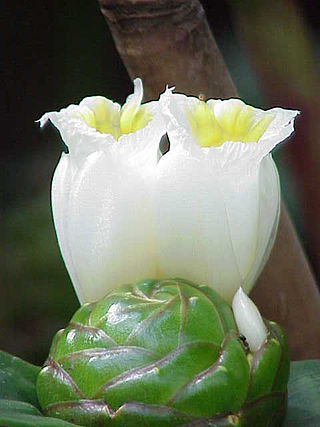
The Zingiberales are flowering plants forming one of four orders in the commelinids clade of monocots, together with its sister order, Commelinales. The order includes 68 genera and 2,600 species. Zingiberales are a unique though morphologically diverse order that has been widely recognised as such over a long period of time. They are usually large herbaceous plants with rhizomatous root systems and lacking an aerial stem except when flowering. Flowers are usually large and showy, and the stamens are often modified (staminodes) to also form colourful petal-like structures that attract pollinators.

Costaceae, known as the Costus family or spiral gingers, is a family of pantropical monocots. It belongs to the order Zingiberales, which contains horticulturally and economically important plants such as the banana (Musaceae), bird-of-paradise (Strelitziaceae), and edible ginger (Zingiberaceae). The seven genera in Costaceae together contain about 143 known species. They are native to tropical climates of Asia, Africa, Central America, and South America. Several species are frequently found in cultivation.

Costus is a genus of herbaceous perennial plants in the family Costaceae, erected by Linnaeus in 1753. It is widespread through tropical and subtropical regions of Asia, Africa, and the Americas.

Asteromyrtus is a genus of flowering plants in the Myrtaceae family. It is closely related to Callistemon and Melaleuca.

Cheilocostus speciosus, or crêpe ginger, is a species of flowering plant in the family Costaceae. Some botanists have now revived the synonym Hellenia speciosa for this species.

Tapeinochilos ananassae, also known as Indonesian wax ginger, Pineapple ginger, Red wax ginger, or Giant Spiral ginger, is an herb in the family Costaceae described as a species in 1866. It is native to Queensland, New Guinea, and the Indonesian Province of Maluku. It is perennial, with a physical height of 6-8 feet and a spread of 5-7 feet. It has evergreen leaves and yellow flowers within red bracts. As a greenhouse or indoor plant, their flowers are valued for their beauty.
Shonia is a genus of plants in the family Euphorbiaceae first described as a genus in 2005. The entire genus is endemic to Australia.
- Shonia bickertonensis(Specht) Halford & R.J.F.Hend. - N NT
- Shonia carinataHalford & R.J.F.Hend. - S Qld
- Shonia territorialisHalford & R.J.F.Hend. - N NT
- Shonia tristigma(F.Muell.) Halford & R.J.F.Hend. - N Qld

Chamaecostus cuspidatus, common name fiery costus or spiral flag, is a species of herbaceous plant in the family Costaceae native to eastern Brazil. In India, it is known as insulin plant for its purported anti-diabetic properties. Chamaecostus cuspidatus has large fleshy-looking leaves. The undersides of these large, smooth, dark green leaves have light purple shade. The leaves are spirally arranged around the stem, forming attractive, arching clumps arising from underground rootstocks. The maximum height of these plants is about two feet. The flowers are orange in color and are 1.5 in (3.8 cm) in diameter. Flowering occurs during the warm months and they appear to be cone-like heads at the tips of branches.

Chamaecostus is a group of flowering plants in the Costaceae described as a genus in 2006. It is endemic to South America.

Dimerocostus is a group of flowering plants in the Costaceae described as a genus in 1891. It is native to Central and South America.

Paracostus is a group of plants in the family Costaceae described as a genus in 2006. It is native to Borneo and to tropical Africa.

Tapeinochilos is a group of plants in the Costaceae described as a genus in 1869. It is native to Queensland, Papuasia, and the Indonesian Province of Maluku. Centered in Papua New Guinea, only three of the approximately 16 species occur outside of the country.

Hellenia is a genus of plants in the Costaceae described as a genus with this name in 1791. It is native to Southeast Asia, southern China, the Indian Subcontinent, New Guinea, and Queensland. The type species was "H. grandiflora" Retz., which is a synonym of Hellenia speciosa.

Cheilocostus is a genus of flowering plant in the family Costaceae, with the type species C. speciosus. Databases are currently inconsistent, with some botanists preferring to place the five species in the genus Hellenia.
The ginger-families or ginger group or Core Zingiberales is a terminal clade in the order Zingiberales (Monocotyledoneae) that comprises Zingiberaceae, Costaceae, Marantaceae and Cannaceae. Their shared synapomorphy of a single fertile anther and four or five highly modified staminodia differentiate them from the basal paraphyletic assemblage of the "banana-families".

Costus malortieanus, known as Stepladder Plant, Spiral Ginger, or Spiral Flag, is a species of perennial herbaceous flowering plant in the family Costaceae. It is native to Costa Rica, Nicaragua and Honduras. Costus malortieanus is often cultivated as an ornamental plant.

Costus dubius is a species of plant native to Tropical Africa.

Costus lucanusianus is a species of plant native to Africa. It is widely distributed across North East Africa, West Africa, Central Africa, East Africa, and Southern Tropical Africa.

Costus afer, English ginger lily or common ginger lily, is a species of plant native to Tropical Africa.
Costus louisii is a critically endangered species of plant endemic to Gabon.















